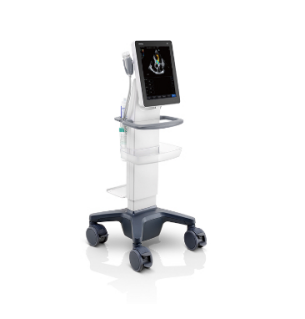The development of ultrasonic diagnosis requires the equipment to be subdivided according to multiple scenarios to provide a diagnostic path that fits each department's needs. Point-of-care ultrasound, also known as another stethoscope for doctors, can be as flexible and convenient as an all-rounder to complete tasks in different bedside scenarios. When it comes to the emergency medical rescue, healthcare professionals need to obtain fast and intuitive results through POC ultrasound for rapid decision-making. When conducting acute and critical bedside assessments, POC ultrasound must be lightweight and long-lasting and provide healthcare professionals with accurate and high-quality imaging to enhance diagnostic confidence. And when guiding interventional punctures, POC ultrasound must help clinicians quickly find the right plane and provide visualization support. Based on this understanding, we hope to make POC ultrasound embed into each clinical scenario's diagnosis and treatment workflow with ease and efficiency. Through standard and reliable imaging results, doctors can quickly make a diagnosis and improve patient care quality.

Emergency:
Saving Lives by Saving Time
The emergency department is one of the busiest places in every hospital. Rescuing patients with cerebral infarction, myocardial infarction, and accidental injuries is everyday work for clinicians. Time is precious. Clinicians are challenged to take decisive actions rapidly. However, it takes time to finish the examination without a problem-directed ultrasound diagnosis process, especially dealing with shock coma and closed injury patients.

To relieve the pressure on emergency department staff, improve the speed and accuracy of clinical decision-making and further ensure patients' lives. We have designed the ME Series POC ultrasound with an emergency workflow in mind. User-defined settings are provided to prioritize the most commonly used probes and scan workflows for one-click switching, and a variety of fast bedside ultrasound protocols, such as FAST and EFATE, are built in to allow doctors to adequately and quickly assess patient status in emergencies.
Protocols for emergency examinations in Mindray’s POC ultrasound.

To relieve the pressure on emergency department staff, improve the speed and accuracy of clinical decision-making and further ensure patients' lives. We have designed the ME Series POC ultrasound with an emergency workflow in mind. User-defined settings are provided to prioritize the most commonly used probes and scan workflows for one-click switching, and a variety of fast bedside ultrasound protocols, such as FAST and EFATE, are built in to allow doctors to adequately and quickly assess patient status in emergencies.

Protocols for emergency examinations in Mindray’s POC ultrasound.
Anesthesia:
Visibility is Safety, a Vision of Anesthetic Puncture
Anesthetic puncture is a task that requires intense concentration and relies heavily on the anesthetist's clinical experience, especially for out-of-plane punctures. Like sailing a boat without detecting the water's depth, the slightest misstep can 'hit the rocks' - puncturing a vessel or piercing a nerve, causing bleeding, pain, and even life-threatening injuries to the patient. An experienced anesthetist often needs to guide the procedure, which is not as efficient as it could be.
eSpacial Navi™ guiding the puncture procedure
Recognizing this pain point, we have developed advanced puncture enhancement technology “iNeedle”, which significantly improve the needle display during the in-plane approach for the extremities, trunk, and spine and other planes. And eSpacial Navi™, which clearly shows the position of the tip and the alignment of the needle, helping to plan the needle trajectory before puncturing and guiding you to the target safer and more accessible, making it easier for even beginners to get started. This innovative technology, available on the Mindray ME series POC ultrasound, enhances the anesthetist’s confidence by providing enhanced puncture visibility, just like GPS navigation.
Moreover, an idea of an intelligent verbal control system, iVocal, arose in observing the scenario that an anesthesiologist is often standing at the bed's head when conducting puncture. While the ultrasound device is at the foot, an extra assistant is needed to perform the procedure.
The intelligent voice assistant, which is commonly used in popular electronics, gave Mindray's R&D team an idea: if we can make POC ultrasound a tablet-like device, why not add an intelligent verbal control system? Thus, iVocal was born, allowing the anesthetist to control the ultrasound by voice while puncturing, making the image presentation more comfortable. Not only does this improve efficiency and save the workforce, but it also reduces the need for repeated sterilization.
The innovative ultrasound guidance solution significantly improves anesthesia work efficiency. Clinical concerns such as needle tip display, puncture guidance, nerves, drug diffusion, and joint cavity gap are clearly presented to the anesthesiologist. It further reduces the chance of anesthesia complications, reduces the anesthetic dose, and protects the safety of anesthesia.

Critical Care:
Empowering Doctors with a Second Pair of Eyes
Patients in ICU mostly have cardiopulmonary, hepatic, and renal organ insufficiency or failure, and their vital signs may change at any time, with body fluids changing rapidly in about 90% of critically ill patients. Gastrointestinal hemorrhage, severe endocrine and metabolic disorders, disturbances in water-electrolyte and acid-base balance, liver, and kidney dysfunction are all common abnormalities in the ICU reflected in changes in body fluids.

Therefore, close fluid monitoring and accurate volume management of patients are of paramount importance. However, ultrasound has the advantage of being more intuitive in the dynamic assessment of patients' cardiopulmonary function and hemodynamics and can help ICU healthcare professionals make timely treatment decisions and observe the effects of treatment in real-time.

Therefore, close fluid monitoring and accurate volume management of patients are of paramount importance. However, ultrasound has the advantage of being more intuitive in the dynamic assessment of patients' cardiopulmonary function and hemodynamics and can help ICU healthcare professionals make timely treatment decisions and observe the effects of treatment in real-time.
From Emergency to Anesthesia, then Critical Care, Mindray's POC ultrasound seamlessly links the workflow of rapid diagnosis, accurate assessment, real-time guidance, and dynamic monitoring in the most convenient way, responding to the needs of clinicians to make accurate and rapid decisions, ensuring clinicians with more confidence to focus on patient care.


